|
The pictures are arranged
by Family.
Return to
Native Plants page. |
__________________________________________________________________________________________________
SHRUBS |
|
ANACARDIACEAE - Sumac Family |
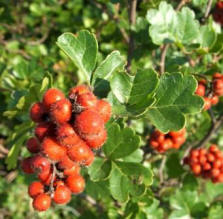
Aromatic sumac - Rhus aromatica
This small shrub is also known as Three-leaf Sumac. Some people
may confuse it with Poison Ivy, which is in the same Family.
However, Aromatic sumac has leaves that are a bit different & it does
not cause acute dermatitis like Poison Ivy does! Aromatic sumac
has nice fall color. The fruit is bright red in the summer & is
consumed by a variety of wildlife. The leaves have a fragrant
smell when crushed or bruised. |
|
|
CORNACEAE - Dogwood Family |
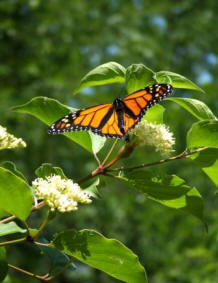
Rough-leaf dogwood with Monarch - Cornus
drummondii
The showy cluster of flowers attracts numerous butterfly species.
Birds devour the fruit. It grows in shady, moist areas, but can
also be seen at harsh sites, such as along railroad tracks. The
shrub reaches up to 10 feet. |
|
|
RHAMNACEAE - Buckthorn Family |
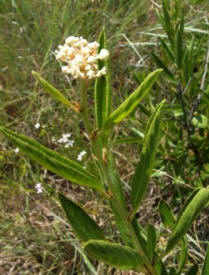
Redroot - Ceanothus herbaceus
Redroot grows on limestone outcrops in our area. They have showy
inflorescences, shiny leaves, & reddish stems. Most Ceanothus
species are common in the chapparal of California. |
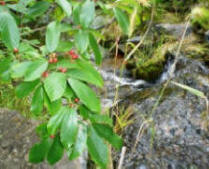
Carolina Buckthorn - Frangula
caroliniana
Carolina buckthorn can be found in shaded woodlands along streams in the
Cross Timbers. It makes a beautiful understory shrub/small tree in
a landscape setting. The red berries provide food for wildlife,
especially birds. |
|
ROSACEAE - Rose Family |
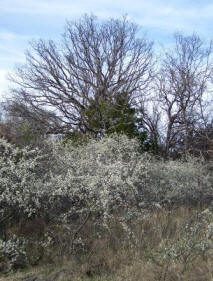
Chickasaw plum - Prunus
angustifolia
This plum forms thickets, which give wildlife ranging from
rabbits to sparrows a place to hide. They put out sweet-smelling
blooms in early spring, and if its a good year, you might be able to
harvest plum fruit to make jelly or jam! Chickasaw plum is an
important plant of the prairies of the Cross Timbers area. These
would make a great corner accent to a wildlife habitat backyard.
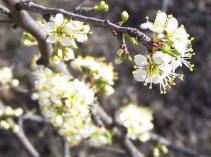
|
|
|
RUBIACEAE - Madder Family |
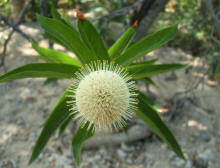
Buttonbush -
Cephalanthus occidentalis
This shrub attracts attention because of the perfect globe
cluster of flowers, which attract many butterflies & hummingbirds, &
many species of birds eat Buttonbush seeds in the fall. The
leaves attach to the stem in a whorl of 3. The shrub reaches from
6 - 12 feet & prefers moist areas where water collects. |
|
|
SAPINDACEAE - Soapberry Family |
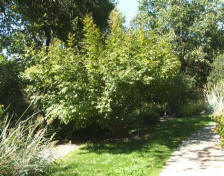
Mexican buckeye -
Ungnadia speciosa
This shrub is not a true buckeye. It can grow to 15 feet &
either be trained as a tree or retain a shrub form. It has
delicate pink blooms in the spring. The seeds are interesting
3-chambered pods that open to release the black marble-like seeds.
This small tree provides visual interest throughout the year with its
flowers, pinnately-compound leaves & its dangling cinnamon-colored seed
pods. |
|
|
VERBENACEAE - Verbena Family |
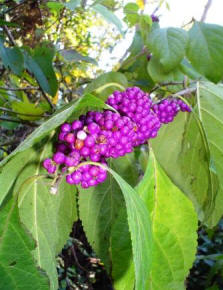
American beautyberry -
Callicarpa americana
American Beautyberry reaches about 5 feet & grows in shady areas
along creeks. The bright coral/purple fruit are a favorite meal of
birds. In a landscape setting, this plant would look good as a
background or specimen under shade-casting trees. If planted in
full sun, this plant will need extra water.
|
|
|
| This listing of native
plants of the Cross Timbers eco-region is not comprehensive. This
is merely a compilation of some plants that can be found locally in
lawns, parks, development sites, and natural areas. If you keep
your eyes to the ground, you'll be surprised at what you might find!
With water conservation in our urban areas
becoming increasingly more important, native plants in our landscapes
can help us save our precious water. Native plants grow naturally
in our soils, climate & unpredictable weather. They are
drought-tolerant and need little attention. Some of these native
plants may not be available in most local nurseries, however, you might
try calling nurseries that specialize in native plants. You always
have the option of propagating these plants from seed or vegetatively.
If nothing else, knowing some native plants will help you appreciate
their role in our environment and urban settings.
Some good resources for ID & to learn
more about native plants of Texas are:
Shinners & Mahler's Illustrated Flora of North Central Texas
by George M. Diggs, Jr., Barney L. Lipscomb,
& Robert J. O'Kennon
Wildflowers of Texas by Geyata Ajilvsgi
Wildflowers of the Texas Hill Country by Marshall Enquist
Texas Wildflowers by Campbell & Lynn Loughmiller
Trees of North Texas by Robert A. Vines
Trees of Texas by Carmine Stahl & Ria McElvaney
Grasses of the Texas Hill Country by Brian & Shirley
Loflin
Common Texas Grasses: An Illustrated Guide by Frank W.
Gould
Texas Wildscapes: Gardening for Wildlife by
Noreen Damude and Kelly Conrad Bender
Landscaping with Native
Plants of Texas by George Oxford Miller
How to Grow Native Plants of Texas & the Southwest by Jill
Nokes
Find out how community volunteers can take
an area that was formerly neglected and overgrown with invasive, exotic
privet and return the site to the Eastern Cross Timbers ecosystem.
Visit the Molly
Hollar Wildscape website to learn more.
Return to Native
Plants page.
|